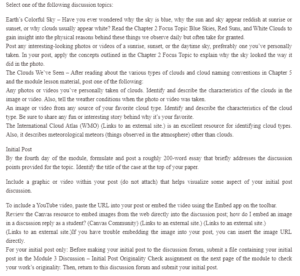Atmospheric Moisture and Clouds
The sky is blue because blue light is scattered more than other colors when the sun’s light hits the atmosphere. The air molecules scatter short-wavelength light more than long-wavelength light (Ahrens & Henson, 2017, p. 48). Blue is at the short-wavelength end of the visible spectrum, which is spread more. That is why the sky is blue most of the time. The eyes are more sensitive to blue light, so the sky looks blue. When people look up there, they see all the blue light scattered by the atmosphere. Get in touch with us at eminencepapers.com. We offer assignment help with high professionalism.
The sun and sky at sunrise and sunset appear reddish because the sunlight passes through a longer path in the atmosphere. A thick atmosphere scatters short-wavelength blue light more than red light. So, when looking through a greater depth of the atmosphere, more blue light is scattered away, leaving mostly red and yellow light (Ahrens & Henson, 2017, p. 48)—the red, yellow, and orange light results from the sunlight passing through a long atmosphere path. The particles filter out short-wavelength blue light more than long red and yellow light.
Clouds usually appear white because they are made up of tiny water droplets or ice crystals. Sunlight reflects off these tiny particles, and all the colors in the light spectrum are scattered equally, so clouds look white most of the time (Ahrens & Henson, 2017, p. 48). The visible wavelengths of sunlight are short, so they are scattered more by tiny water droplets and ice crystals (Meyer & Overen, 2019). They are scattered equally in all directions, so when we look up at the clouds, we see all the colors of sunlight scattered equally, which looks like white light.
Figure 1 Reddish Sunset
References
Ahrens, C. D., & Henson, R. (2017). Meteorology today: an introduction to weather, climate, and the environment. Cengage learning.
Meyer, E. L., & Overen, O. K. (2019). Blue skies and red sunsets: Reliability of performance parameters of various pn junction photovoltaic module technologies. Cogent Engineering, 6(1), 1691805.
ORDER A PLAGIARISM-FREE PAPER HERE
We’ll write everything from scratch
Question

Atmospheric Moisture and Clouds
Select one of the following discussion topics:
Earth’s Colorful Sky – Have you ever wondered why the sky is blue, why the sun and sky appear reddish at sunrise or sunset, or why clouds usually appear white? Read the Chapter 2 Focus Topic Blue Skies, Red Suns, and White Clouds to gain insight into the physical reasons behind these things we observe daily but often take for granted.
Post any interesting-looking photos or videos of sunrise, sunset, or the daytime sky, preferably one you’ve personally taken. In your post, apply the concepts outlined in the Chapter 2 Focus Topic to explain why the sky looked the way it did in the photo.
The Clouds We’ve Seen – After reading about the various types of clouds and cloud naming conventions in Chapter 5 and the module lesson material, post one of the following:
Any photos or videos you’ve personally taken of clouds. Identify and describe the characteristics of the clouds in the image or video. Also, tell the weather conditions when the photo or video was taken.
An image or video from any source of your favorite cloud type. Identify and describe the characteristics of the cloud type. Be sure to share any fun or interesting story behind why it’s your favorite.
The International Cloud Atlas (WMO) (Links to an external site.) is an excellent resource for identifying cloud types. Also, it describes meteorological meteors (things observed in the atmosphere) other than clouds.
Initial Post
By the fourth day of the module, formulate and post a roughly 200-word essay that briefly addresses the discussion points provided for the topic. Identify the title of the case at the top of your paper.
Include a graphic or video within your post (do not attach) that helps visualize some aspect of your initial post discussion.
To include a YouTube video, paste the URL into your post or embed the video using the Embed app on the toolbar.
Review the Canvas resource to embed images from the web directly into the discussion post; how do I embed an image in a discussion reply as a student? (Canvas Community) (Links to an external site.) (Links to an external site.)
(Links to an external site.)If you have trouble embedding the image into your post, you can insert the image URL directly.
For your initial post only: Before making your initial post to the discussion forum, submit a file containing your initial post in the Module 3 Discussion – Initial Post Originality Check assignment on the next page of the module to check your work’s originality. Then, return to this discussion forum and submit your initial post.


